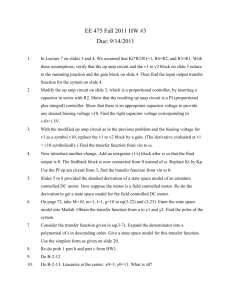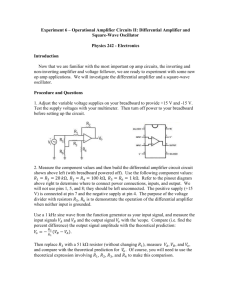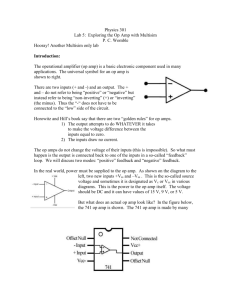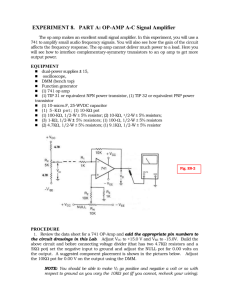Lab 9: Op Amps Lab Assignment 3 class days
advertisement
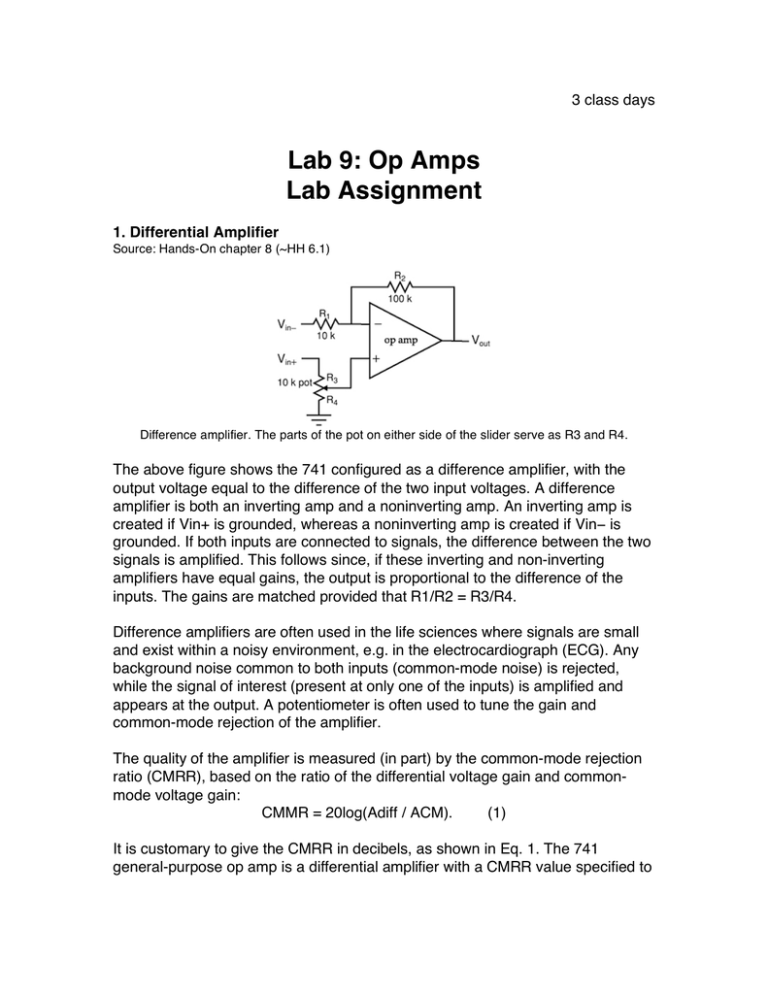
3 class days Lab 9: Op Amps Lab Assignment 1. Differential Amplifier Source: Hands-On chapter 8 (~HH 6.1) Difference amplifier. The parts of the pot on either side of the slider serve as R3 and R4. The above figure shows the 741 configured as a difference amplifier, with the output voltage equal to the difference of the two input voltages. A difference amplifier is both an inverting amp and a noninverting amp. An inverting amp is created if Vin+ is grounded, whereas a noninverting amp is created if Vin− is grounded. If both inputs are connected to signals, the difference between the two signals is amplified. This follows since, if these inverting and non-inverting amplifiers have equal gains, the output is proportional to the difference of the inputs. The gains are matched provided that R1/R2 = R3/R4. Difference amplifiers are often used in the life sciences where signals are small and exist within a noisy environment, e.g. in the electrocardiograph (ECG). Any background noise common to both inputs (common-mode noise) is rejected, while the signal of interest (present at only one of the inputs) is amplified and appears at the output. A potentiometer is often used to tune the gain and common-mode rejection of the amplifier. The quality of the amplifier is measured (in part) by the common-mode rejection ratio (CMRR), based on the ratio of the differential voltage gain and commonmode voltage gain: CMMR = 20log(Adiff / ACM). (1) It is customary to give the CMRR in decibels, as shown in Eq. 1. The 741 general-purpose op amp is a differential amplifier with a CMRR value specified to be at least 70 dB. Precision op amps are commercially available with CMRR values as high as 140 dB or more. Build the circuit shown. You can estimate the common-mode rejection ratio by measuring both the common-mode voltage gain and the differential voltage gain. The common-mode voltage gain is determined by applying identical signals to both inputs and observing the output voltage: Using a 1 kHz sine wave at maximum amplitude as your input, tune your difference amp to minimize the output amplitude (i.e. adjust the potentiometer until the output amplitude is as small as possible). The best estimate for the common-mode gain can be made using the averaging feature from the ‘ACQUIRE’ menu of the TDS210 oscilloscope. It may be possible, depending on the quality of your op amp, to tune the potentiometer such that no output signal is visible, even at the most sensitive scale. * Verify that R1/R2 = R3/R4. * Estimate (or set an upper limit on) the common-mode voltage gain. The resistance ratios can be measured using your meter; however, be sure to turn off the power and disconnect each component before making your measurements – accurate resistance measurements cannot be guaranteed if the component remains connected to the circuit, since then you are measuring a parallel combination with the other components rather than just the resistance of interest. For example, when measuring the resistances between the potentiometer center tap and ends, be sure to disconnect all wires connecting the pot to the input signal, op amp, and ground. Replace all resistors and wires when done. To measure the differential voltage gain, ground one input while applying a 1 kHz sine wave of amplitude 1 V or less at the other input. It shouldn’t matter which input you ground. If you’re curious, try it both ways and see if you get equal gains. * Measure the differential voltage gain. * Explain why it doesn’t matter which input is grounded when measuring the differential voltage gain. * Estimate the CMRR for this circuit. * What is the input impedance at each input? 2. Summing Amplifier Source: Hands-On chapter 7 (~HH 8.7) This circuit is fun to build and to observe in action. It also serves as an excellent demonstration of the constructive and destructive interference between two waveforms. Fancy summing circuit. Amp 1 is a voltage follower used to buffer the 60 Hz pickup on a wire wrapped around an AC power cord. Amp 2 is a noninverting summing amplifier with unity gain. Amp 3 is a difference amplifier with an adjustment to maximize the CMRR. Difference amplification is usually used to eliminate common-mode noise. The circuit shown above sums two waveforms and then eliminates one using the difference amp. Both waveforms will be from function generators. First construct the voltage follower and summing amplifiers as shown. Set the function generator to a sine wave with a frequency between 59 and 61 Hz. Adjust the generator amplitude to match the amplitude of the voltage follower and observe the output of the summing amp. The output should be the linear sum of the two input waveforms. Have fun with the circuit by changing the amplitude and frequency. Observe what happens with either a triangle- or square-wave input. Using the ‘AC line’ as your trigger source may be useful here. Now add the difference amplifier. With the function-generator amplitude set to zero, adjust the potentiometer until the difference amp output has zero amplitude (as with the difference amplifier previously built). Now increase the amplitude of your function generator and observe the difference amplifier output. Be sure to switch your trigger source back to the appropriate input channel. Try changing the input frequency. Replace the 60 Hz AC-line signal at the noninverting input of the difference amp with the output from the function generator. Observe how the output changes. Explain how this circuit works using diagrams and equations as needed. Explain why the summing amp isn’t inverting and why it has unity gain. Sketch the inputs and output of the summing amp for a function generator frequency near 60 Hz. Why doesn’t the output have a well defined amplitude? Sketch the inputs and output of the difference amplifier. How does the output change when the inputs are switched? Is the output inverted with respect to the original inputs? If so, why? If so, what could you change to make the output of the difference amp noninverted with respect to the original inputs? 3. Integrator Source: Curtis, lab9 (HH 9.2) In the frequency domain, integration amounts to division by jω. We do not want to integrate any constant or DC part of the input signal (or any output offset in the op-amp), so we set a maximum gain or cut-off to the (jω)−1 dependence. This is done by introducing the resistor Rf in parallel with the feedback capacitor Cf as shown in the figure below. For ωRfCf ≫ 1 the feedback impedance is (jωCf )−1, and the circuit behaves as an integrator. For ωRfCf ≪ 1 the feedback impedance goes to Rf, and the gain approaches Rf/Ri instead of diverging. Tntegrator circuit, including feedback resistor to introduce a low frequency cutoff. • Choose Rf. Use an input resistance Rin = 1k. (Smaller values would reduce the input impedance and larger values would make the following steps more difficult.) Once Rin is fixed, the DC gain is determined by the value of Rf. If the gain is to decrease with increasing frequency, it is best to have large factor multiplying the (jω)−1 – i.e., the low frequency gain should be large. Pick Rf so that the DC gain is 100. • Choose Cf. Suppose you want to integrate an input signal whose fundamental frequency is 50 Hz or greater. Choose an appropriate value of Cf so that the circuit will act like an integrator down to about 50 Hz. Compute and sketch the expected form of the frequency response (magnitude) curve, |G(ω)| (at this point, you shouldn’t have to do a complete calculation to sketch this curve!). • Build the circuit. • Verify that the frequency response of the circuit goes as 1/f in the appropriate frequency range. Note that you can also think of this as a low pass filter – but one with gain, in contrast to the passive RC circuit studied earlier. • Use a square wave input with a fundamental frequency above the −3 dB point and show that the output resembles the integral. Try other available waveforms. What happens when the input signal frequency becomes too low? 4. Differentiator Source: Curtis, lab9 (HH 9.3) Differentiation corresponds, in the frequency domain, to multiplication by jω. Now we have increasing gain as the frequency increases. As you have seen before, the increasing gain will be cut off by the op-amp gain at some point. It is best to have the cut-off determined by external elements instead. High gain at high frequency may also cause slew rate problems for this circuit. By introducing the input resistor Rin, the gain at high frequencies is reduced to Rf/Rin. Differentiator circuit, including input resistor to introduce high frequency cutoff. 1. Choose Rin, Cin, and Rf. In this case, referring to the circuit in the figure, we want to set the high frequency gain to be high. Set this gain to be 100 and the minimum input impedance to be 1 k. Set the upper frequency for differentiation to be 5 kHz (this is also the -3 dB point of the high pass filter). Again, compute and sketch the expected shape of the frequency response. 2. Build the circuit shown. 3. Measure the frequency response (magnitude only), over the relevant frequency range. Does the circuit work as designed? Discuss reasons for any deviations from your expectations. 4. Differentiate both a square wave and a triangle wave. For the triangle wave, quantitatively compare with the expected amplitudes of the derivative. Vary the fundamental frequency of the input waves and observe the circuit limitations at low and high frequencies. You may observe a ringing response to the square wave; compare the period of the ringing to the characteristic time determined by your frequency response curve. 5. Active Rectifier HH 9.5. Answer all questions. 6. Improved Active Rectifier HH 9.6. Answer all questions.

